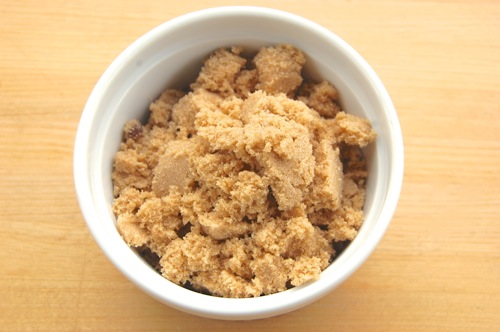Brown Sugar (Light)

Mass-market American brown sugar is a refinery sugar, made by re-melting and re-crystallizing the sugar supplied by the original sugar miller. It may simply be a more uniform version of the raw sugar with its original molasses still on it. Alternately, it may be a white table sugar that has been “painted” with molasses. Either way, it’s a “wetter”, softer and denser sugar than most “raw” brown sugars. These brown sugars are about 90% sucrose, the remainder being glucose and fructose, minerals (including salts), water, begasse (browned bits of the sugarcane plant) and longer-chain sugars that don’t taste especially sweet on our tongues. All these combine to give brown sugar a variety of buttery, salty and caramel-like notes. Brown sugar is an acidic ingredient as the molasses it contains is high in acetic acid (which can give it some vinegar-like aromas as well).
Hi Joe,
So brown sugar is an acidic ingredient huh? That one caught me off guard. I’ve always used a touch of brown sugar to tame the acid of my tomato sauces because it adds more flavor depth than just regular table sugar. Now I find out I’m just adding more acid to the mix. Is the acidity anything worth being concerned over when swapping table sugar for brown sugar in recipes?
Thanks!
Eva
Hey Eva! Good question. The answer is extra acidity generally doesn’t hurt anything, so you’re good there. The main thing to consider when swapping brown sugar for white is the liquid nature of molasses, which can impact texture depending on what the recipe is like.
Thanks for that!
– Joe
Huh – this might explain why my favorite oatmeal cookie recipe calls for baking soda instead of baking powder. I’d always wondered!
Yep…same with chocolate chip cookies! It’s the molasses.
Cheers,
– Joe
Thank you for your response!
It was added into the bread dough. It was in grams, 135 of them to be exact. The only thing I was able to find from searching online was that it’s a lighter than light brown sugar but nothing more specific than that. I shop at a lot of specialty stores and normally my first stop is to the baking aisle and I have never seen anything called golden sugar before. This is the link to the recipe:
http://www.mademoisellecocotte.com/post/2483922589/applecinnamoncrunchloaf
Hm. I think your instinct must be right, that it’s some sort of very light brown sugar, like a Demerara. Very interesting. Thanks Rachel!
I ended up using half light brown sugar, and half granulated sugar. When I mixed it up, it was a nice golden color and it worked well in the recipe. Thank you again!
Terrific, Rachel! Thanks for checking back in with me!
– Joe
Hi Rachel,
I’m the one who wrote the recipe on the blog that you visited. Golden sugar is the name that a Canadian brand of sugar uses to label their light brown sugar. It’s the same thing as a light brown sugar. They call it “Golden yellow sugar” . I’ll change the name on the recipe so people don’t get confused.
Ani
Today I found a bread recipe that called for golden sugar. It’s a recipe from Vancouver so I don’t know if this is a product that just isn’t sold in the US, but I figured you might be the right person to take this to since you’re running a sugar series! Have you heard of golden sugar, or know what it is? Thank you!
Hey Rachel!
Hm…not really no. Golden syrup yes. Is it sprinkled on top or added to the doughr? Also, in the recipe is it measured by weight or volume? That might give a clue.
– Joe
Oops, I hit respond on the wrong comment. It’s on the comment above this one, sorry!
In South Africa we have golden sugar. It’s basically ‘unbleached’ white sugar, it looks and behaves like white sugar in recipes. It has the texture of white sugar and the colour of your light brown sugar (which we do not have). So from a bread baking point of view I would just replace it with white sugar with no impact at all.
Very interesting. Thanks again, Naomi!
– Joe